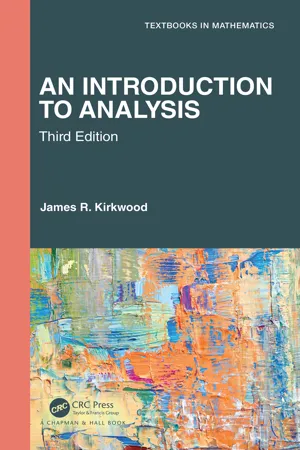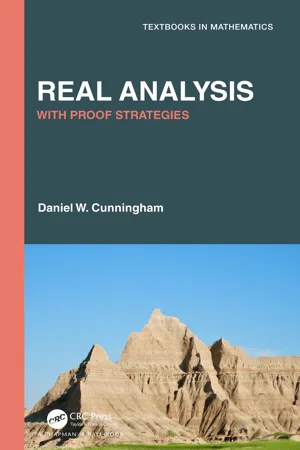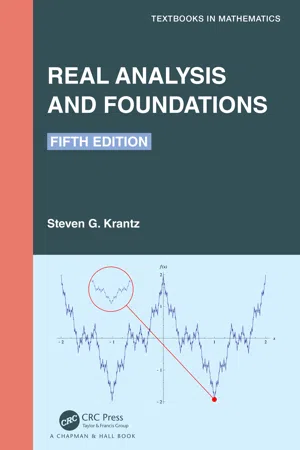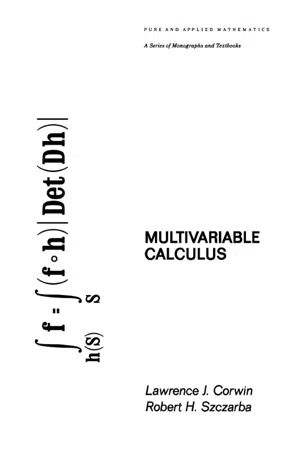Mathematics
Alternating Series
An alternating series is a series in which the terms alternate in sign, such as +a - b + c - d. For an alternating series, the terms must decrease in absolute value and approach zero as the series progresses. The alternating series test is a method used to determine the convergence of such series.
Written by Perlego with AI-assistance
Related key terms
1 of 5
5 Key excerpts on "Alternating Series"
- eBook - ePub
- Seymour B. Elk(Author)
- 2016(Publication Date)
- Bentham Science Publishers(Publisher)
n . Examining the three reference sequences listed above, observe that:(1) an alternation of the single element sequence (1, 1, 1, …); namely (−1, +1, −1, +1, . . .) is an example of divergence because a common value is not approached; (2) an alternation of the identity sequence (1, 2, 3, . . .); namely (−1, +2, −3, +4, . . .) is also an example of divergence inasmuch as the individual terms approach infinity; (3) an alternation of the alternating reciprocals sequence not only converges (to 0), it converges much faster than does any all-positive reciprocal sequence. A formalism comparable to that of Chapter 3, replaces “ε - δ proofs”, with a corresponding “ε - N proof”, along with a similar formal definition:“Sequence {an } converges to a limit L when for every real number ε > 0 there exists a number N (called an “index”) such that, for all n > N, thereby demonstrating that │an − L│< ε.”Given the sequence of reciprocal integers, starting with n =1. By plugging in numbers and observing the trend, one concludes that this sequence converges to 0; i.e., {an } = and L = 0. This is illustrated by selecting ε = 0.1 and limit N = 11. Now, for all n>N:7.2.. INFINITE SERIES
Just as the sequence of comparable terms, denoted as a1 , a2 , a3 … an , is of major interest in the evolution of the concept “what is mathematics?”, the addition of successive individual terms, called a “series” is of even greater utility. Given such a sequence, attention may be focused on the corresponding series:s1 = a1 ; s2 = a1 + a2 , …, sn = a1 + a2 + …. + an .Moreover, when there are an infinite number of such terms added together, this sum, referred to as an “infinite series” will be shown to be the basis for re-defining many of the important functions of arithmetic, algebra, trigonometry and calculus. In the same manner as attention was focused on selected reference sequences, an examination of the corresponding series is in order: - eBook - ePub
- James R. Kirkwood(Author)
- 2021(Publication Date)
- Chapman and Hall/CRC(Publisher)
Then we shall investigate the questions of whether certain manipulations with series, in particular grouping and rearranging the terms, are valid. The answers depend on whether a series converges and the way in which it converges. Next, we discuss series in which the sign of each term differs from that of its predecessor (Alternating Series). Finally, we discuss the multiplication of two series. Definition: A series ∑ a n is said to be absolutely convergent if ∑ | a n | converges. If ∑ a n converges but ∑ | a n | diverges, the series is said to be conditionally convergent. Example 7.9: Let ∑ a n = 1 − 1 + 1 / 2 − 1 / 2 + 1 / 3 − 1 / 3 + ⋯. If S n is the sequence of partial sums for the series, then S n = { 0 if n is even 2 n + 1 if n is odd. Thus lim S n = 0, so the series converges to 0. However, ∑ | a n | = 1 + 1 + 1 / 2 + 1 / 2 + 1 / 3 + 1 / 3 ⋯ diverges, so the series is conditionally convergent. Theorem 7.10: If a series is absolutely convergent, then it is convergent. Proof: Let ∑ a n be an absolutely convergent series. Let { S n } be the sequence of partial sums associated with ∑ a n, and let { T n } be the sequence of partial sums associated with ∑ | a n |. We use the Cauchy criterion to prove the theorem. Let ϵ > 0 be given. Since ∑ | a n | converges, { T n } converges. So there is a number N such that if m > n > N, then | T m − T n | < ϵ. Now | S m − S n | = | a m + ⋯ + a n + 1 | ≤ | a m | + ⋯ + | a n + 1 | = | T m − T n | by the triangle inequality. Therefore, if m > n > N, then | S m − S n | < ϵ ; that is, { S n } is a Cauchy sequence. Thus { S n } converges, and so does the series ∑ a n. ▪ Corollary 7.7: Let ∑ a n be a series of nonzero, but not necessarily positive, terms. Let R = lim ¯ | a n + 1 | | a n | and r = lim ¯ | a n + 1 | | a n |. Then the series ∑ a n converges absolutely if R < 1 and diverges if r > 1. ▪ Corollary 7.8: Let ∑ a n be a series, not necessarily of positive terms - eBook - ePub
Real Analysis
With Proof Strategies
- Daniel W. Cunningham(Author)
- 2021(Publication Date)
- Chapman and Hall/CRC(Publisher)
7Infinite Series
Around 1665, Newton discovered that any binomial of the form, where( 1 + x )rr ∉ ℕand, can be expressed as an infinite series. In 1673, Leibniz discovered that π can be written as an infinite series. For Newton and Leibniz, infinite series were of fundamental importance in their development of calculus; however, during these times, questions of rigor and convergence were of secondary importance.| x |< 1One typically first studies infinite series, in a standard calculus course, without going deeply into the theory of infinite series. In this chapter, using the results in Chapter 3 on the convergence of sequences, we will prove the important theorems that concern an infinite series of real numbers. In Section 7.1, we introduce the concept of a convergent infinite series, and discuss a variety of different kinds of infinite series. We then examine in Section 7.2 a range of tests for convergence. Finally, in Section 7.3 we investigate the effect of regrouping and rearranging the terms of an infinite series.7.1 CONVERGENCE AND DIVERGENCE
As we have seen, the completeness axiom and the limit operation are critical components in real analysis. In particular, these concepts are used to develop the derivative and the Riemann integral. The limit concept was also used in our study of sequences, and it will again be used in our examination of infinite series.Definition. (Infinite Series). Given a sequence〈of real numbers, the nth partial sumsa n〉nis defined bys n==∑k = 1na ka 1+a 2+a 3+ ⋯ +a n.We refer to the sequence〈of partial sums as the infinite seriess n〉. The real numbers∑k = 1∞a kare called the termsa 1,a 2,a 3, … - eBook - ePub
- Steven G. Krantz(Author)
- 2022(Publication Date)
- Chapman and Hall/CRC(Publisher)
3 Series of Numbers DOI: 10.1201/9781003222682-4 3.1 Convergence of Series In this section we will use standard summation notation: ∑ j = m n a j ≡ a m + a m + 1 + ⋯ + a n. A series is an infinite sum. One of the most effective ways to handle an infinite process in mathematics is with a limit. This consideration leads to the following definition: Definition 3.1: The formal expression ∑ j = 1 ∞ a j, where the a j s are real or complex numbers, is called a series. For N = 1, 2, 3, …, the expression S N = ∑ j = 1 N a j = a 1 + a 2 + … a N is called the N th partial sum of the series. In case lim N → ∞ S N exists and is finite we say that the series converges. The limit of the partial sums is called the sum of the series. If the series does not converge, then we say that the series diverges. Notice that the question of convergence of a series, which should be thought of as an addition process, reduces to a question about the sequence of partial sums. Example 3.2: Consider the series ∑ j = 1 ∞ 2 − j. The N th partial sum for this series is S N = 2 − 1 + 2 − 2 + ⋯ + 2 − N. In order to determine whether the sequence { S N } has a limit, we. rewrite S N as S N = (2 − 0 − 2 − 1) + (2 − 1 − 2 − 2) + … (2 − N + 1 − 2 − N). The expression on the right of the last equation telescopes (i.e., successive pairs of terms cancel) and we find that S N = 2 − 0 − 2 − N. Thus lim N → ∞ S N = 2 − 0 = 1. We conclude that the series converges. □ Example 3.3: Let us examine the. series ∑ j = 1 ∞ 1 j for convergence or divergence. (This series is commonly called the harmonic series because it describes the harmonics in music.). Now S 1 = 1 = 2 2 S 2 = 1 + 1 2 = 3 2 S 4 = 1 + 1 2 + (1 3 + 1 4) ≥ 1 + 1 2 + (1 4 + 1 4) ≥ 1 + 1 2 + 1 2 = 4 2 S 8 = 1 + 1 2 + (1 3 + 1 4) + (1 5 + 1 6 + 1 7 +[--=PLGO-SE - eBook - ePub
- L. Corwin(Author)
- 2017(Publication Date)
- CRC Press(Publisher)
16 Infinite Series This chapter is devoted to the study of infinite series. We begin by defining what it means for an infinite series to converge. We then give various tests for determining convergence, first for series of nonnegative terms and afterwards for more general series. 1. Infinite Series Suppose a 1 a 2,. . . , a n,. . . is an infinite sequence of real or complex numbers. Our first problem is to make sense of the sum of the infinite series Σ j = 1 ∞ a j = a 1 + a 2 + ⋯ + a n + ⋯ (1.1) To do this, we define the sequence of partial sums, S 1 S 2,. . . , S n,. . . by S k = a 1 + a 2 + ⋯ + a k = Σ j = 1 k a j If the sum (1.1) is to make sense, this sequence should clearly converge to the sum. Accordingly, we say that the infinite series (1.1) converges with sum S if the sequence of partial sums converges to S ; that is, if lim k → ∞ S k = S If the series (1.1) does not converge, we say that it diverges. Of course, an infinite series need not begin with the term a 1 ; it could equally well begin with a 2, a 7, a 100, or any other term. We shall generally begin series with a 0 or a 1, however. Here are some examples. The series Σ j = 1 ∞ 1 2 j = 1 2 + 1 4 + 1 8 + ⋯ converges to 1. The sequence of partial sums is { 1 2, 3 4, 7 8, ⋯, 1 − 1 2 n, … } which clearly converges to 1. The series Σ j = 1 ∞ 1 j (j + 1) = 1 2 + 1 6 + 1 1 2 + 1 2 0 + ⋅ ⋅ ⋅ also converges to 1. Notice that 1/ j (j + 1) = 1/ j − 1/(j + 1); thus the series is (1 - 1 2) + (1 2 - 1 3) + (1 3 - 1 4) + ⋅ ⋅ ⋅ and the sequence of partial sums is {1 — { 1 - 1 2, 1 - 1 3,..., 1 - 1 / n,... }, which has limit 1. The. series Σ j = 1 ∞ 1 = 1 + 1 + 1 + ⋅ ⋅ ⋅ diverges. The sequence of partial sums is {1, 2, 3, 4,. . . } which clearly has no limit. The series Σ j = 0 ∞ (- 1) j = 1 - 1 + 1 - 1 + 1 - 1 + ⋯ also diverges. The sequence of partial sums is {1, 0, 1, 0, 1, 0,... } which does not have a limit. The series ∑ j = 1 ∞ 1 j (the harmonic series) also diverges
Index pages curate the most relevant extracts from our library of academic textbooks. They’ve been created using an in-house natural language model (NLM), each adding context and meaning to key research topics.




